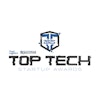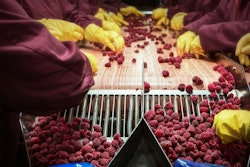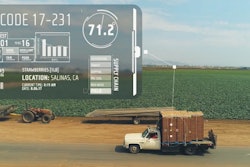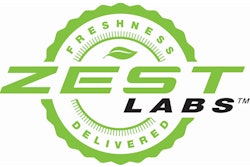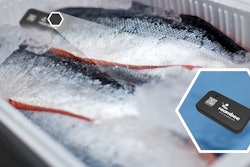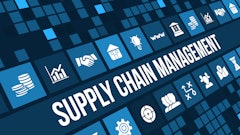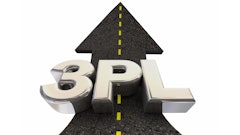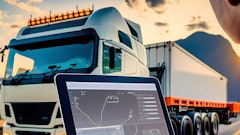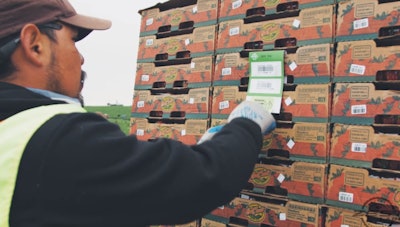
The Internet of Things (IoT) is no stranger to the food supply chain. Network-connected temperature and humidity sensors have long allowed shippers to monitor cold storage facilities and refrigerated trailers, triggering alerts to avoid spoilage or pinpoint potential contaminations before they reach the consumer. In the past, much of the talk around IoT, however, has focused on the devices themselves. Today, advances in wireless technology are shifting the conversation to the cloud and how the information collected by those devices can become more manageable and thus actionable.
IoT solutions can now communicate on their own through wireless technology, allowing data to be aggregated in real-time in the cloud. With less data being collected manually, insights can be gathered at the product level—whether it's the pallet or the carton— and translated into real, actionable information, such as shelf life, inventory status, whether to a hold or ship a product, and how far to ship it.
“There's been an evolution of temperature loggers from 10 or 15 years ago. Even if they started out as mechanical or chemical, they've always tested temperature in different environments, but they weren't doing anything to manage the products,” explains Peter Mehring, CEO of Zest Labs. “If you just manage the trailer, there are obvious things you don't see. You miss how the product is actually being handled and, therefore, you can't make [good] decisions about the product.”
Log in to view the full article
The Internet of Things (IoT) is no stranger to the food supply chain. Network-connected temperature and humidity sensors have long allowed shippers to monitor cold storage facilities and refrigerated trailers, triggering alerts to avoid spoilage or pinpoint potential contaminations before they reach the consumer. In the past, much of the talk around IoT, however, has focused on the devices themselves. Today, advances in wireless technology are shifting the conversation to the cloud and how the information collected by those devices can become more manageable and thus actionable.
IoT solutions can now communicate on their own through wireless technology, allowing data to be aggregated in real-time in the cloud. With less data being collected manually, insights can be gathered at the product level—whether it's the pallet or the carton— and translated into real, actionable information, such as shelf life, inventory status, whether to a hold or ship a product, and how far to ship it.
“There's been an evolution of temperature loggers from 10 or 15 years ago. Even if they started out as mechanical or chemical, they've always tested temperature in different environments, but they weren't doing anything to manage the products,” explains Peter Mehring, CEO of Zest Labs. “If you just manage the trailer, there are obvious things you don't see. You miss how the product is actually being handled and, therefore, you can't make [good] decisions about the product.”
Zest Labs has been on the forefront of product- or pallet-level monitoring, using sensors to understand the attributes and monitor the conditions specific to the product rather than just the environment the product was placed in. The shift now is taking that a step further and asking, “What can I do now that I have this data?”
“Once you know enough about the product and how it reacts to those conditions, you can get into things like freshness management and predictive analytics,” says Mehring, adding, “But the big paradigm shift in using IoT is the cloud software and the wireless communications combining to make that manageable.
“We're seeing new things in the data that people didn't think of, and then you build that into the cloud analytics, and say, ‘Okay, every time this happens, let's tell them to make a better decision.’ And I think that's going to continually happen for the next few years. As more data becomes available, we'll see trends and insights that will make everything more efficient,” he adds.
The Value Is in Predictive Analytics
When it comes to IoT, Ricardo Gomez-Ulmke, vice present of IoT at Solace, and Mehring both acknowledge that its greatest value ultimately will lie in its predictive capabilities.
“Once you’ve reached that stage, you can make the biggest difference in terms of adding value to your end customer,” Gomez-Ulmke says.
A large gap in adoption still remains, however, with very few companies actually reaching that stage of predictive management. Gomez-Ulmke estimates that about 50 percent of companies understand they need to receive more data in real time and are working toward reaching a proactive stage of data management, while 40 percent still don’t even know where to start. That leaves just 10 percent of companies that are utilizing real-time IoT data to predictively manage their supply chain.
The gap, Mehring says, is in the data processing stage.
“Most of the analytics today have been filtering data to prioritize it versus assimilating the data and saying, ‘this is what it means,’” says Mehring. “We we’re very early in doing that with Zest Fresh, turning it into a prediction to say, ‘this is what it means to shelf life, and if that's what the conclusion is, here's what you should do about it.’”
The key to achieving those predictive capabilities, he adds, is comprehensive data collection at the product level, communicating that reliably and then using analytics to process it into actionable insights.
“A number of solutions in the industry have missed the analytics side, the cloud side,” Mehring says. “They have good devices, and they've learned to push the data to the cloud, but they haven't really finished it by saying, ‘And what do you as a customer care about?’ You have to do that translation, otherwise they don't know what to do with it, and like any user of computers, you quickly get frustrated and ignore it.”
Solace recently partnered with supply chain software provider CargoSmart that has simplified the translation of its customers IoT data to answer three questions:
- Where is my cargo?
- Who has it?
- And is it in good condition?
“Their customers basically told them, ‘Hey, I'm going to put this IoT device into my box, but I want you, CargoSmart, to then track the data that this box emits in real time, and tell me about it,’" Gomez-Ulmke explains.
Through its partnership with Solace, which creates what it calls a global event mesh that allows people to exchange data and IoT events in real time, CargoSmart can do this at an extremely fine-grained level for every party involved in the shipping process, creating a collaborative network for end-to-end supply chain visibility.
“When you ship something, you have a carrier and you have a shipper. Potentially, you have a truck that brings the container to the port, and maybe you have a rail system. All of these participants in that shipping process would like to see real-time information about where their cargo is and when it's going to arrive,” says Gomez-Ulmke. “As an end customer, the earlier I know that my shipment of food or my medical supplies might not be the quality that I expect, I can start making preparations to replace them, get a new shipment going, or manage it in a much more proactive way.”
Beyond understanding the location and condition of the products, pallet-level monitoring can also provide insights into operations, such as: What's the cadence that I get those pallets at? How efficient is my crew at harvesting? How many trucks do I really need to transport the product from the field to the processing plant and then the pack house? How do I load level that? How do I get the most efficiency and prequel, or processing, or fresh cut?
“All of that ancillary information about the product and how it's being handled suddenly becomes a key to managing operational efficiency for the growers,” says Mehring. “We've already seen that very directly with the growers we work with. When things change, they receive push notifications on a mobile app that tells them, ‘Do something about this.’ They can fix it in real time, and that's been enabled by IoT in the sense that the data is readily available, it's pushed up to the cloud, and the cloud can determine what the worker needs to know.”
Challenging Long-held Beliefs
Zest Fresh has been collecting product-level data for almost three years, and the findings challenge many long-held beliefs, forcing the food and beverage industry to become proactive in a way they’re still not ready for.
For example, there's a long-held belief that produce harvested on the same day has the same shelf life. If each item has the same date printed on its label, retailers have traditionally believed it must have the same freshness. But Mehring says once you look at the data, you see that's just not true.
“What we show is no, the variability can be up to five days in a single load,” he adds. “But some people don't want to believe that, because then they have to act on it.”
Guilda Javaheri, chief technology officer at Golden State Foods (GSF), one of the largest diversified food processors and distributors in the United States, say advancements in IoT technology are also enabling industry players to redefine fresh.
“The challenge for the supply chain is to improve the level of granularity for temperature and quality monitoring. We need to be more specific about the exact temperature required by each product to sustain its properties as the industry continues to move away from preservatives,” she says.
Fortunately (or unfortunately depending on who you ask), industry pressures will continue to force players in the food supply chain to leverage IoT data and analytics.
“There's recently been pressure on pricing that's forced everyone to look at how to reduce waste and thus improve efficiency. That's pushed for new technology,” Mehring says.
Additionally, there’s an obvious push for improved food safety. Much of that conversation over the last few years has revolved around blockchain, but Mehring predicts IoT and blockchain will go hand-in-hand in the future.
“There's still a weak link to entering the data into the blockchain,” he notes. “Even though blockchain is very good once it has the data, the weak link is the manual entry. IoT is a great way to do that because when you use devices not only is it comprehensive, it's authenticated, and it's not manual entry.”
GSF and IBM have partnered on pilot projects that explore solutions for this weak spot. In 2017, GSF unveiled two pilot programs in 2017 utilizing IBM’s Watson IoT solution, and today, the company continues to focus on finding solutions to obtain trusted supply chain data in an automated fashion—more specifically using IoT to drive a reinvention of the restaurant industry’s ecosystem.
“We’ve proven that IoT can be leveraged to obtain reliable data around package movement and product quality (i.e., temperature), but we’ve also learned that just capturing this data in siloes does not drive industry-wide change,” says Javaheri. “That’s why we are also looking to blockchain as a mechanism to share this data across supply chain partners to drive process standardization and transparency across the system.”
Follow Amy Wunderlin on Twitter.

